John Bedloe Goddard
English ( b.1838 - d.1896 )
Kimmeridge Bay & The Clavell Tower, The Purbecks, Dorset, 1876.
| Image size | 12.4 inches x 23.4 inches ( 31.5cm x 59.5cm ) |
| Frame size | 20.3 inches x 31.3 inches ( 51.5cm x 79.5cm ) |
£3,695.00
Available for sale from Big Sky Fine Art in the English county of Dorset, this Victorian watercolour painting is by John Bedloe Goddard and is dated 1876.
The painting is presented and supplied in its 1960s wooden frame (which is shown in these photographs), mounted using new conservation materials and behind glass.
This antique painting is in good condition, defying its age. It is supplied ready to hang and display.
The watercolour is signed and dated lower right.
John Bedloe Goddard was a well-respected British artist known for his detailed and evocative landscapes, often capturing the natural beauty of rural England. Although he may not be widely recognized in the broader history of 19th-century British art, Goddard’s work reflects a deep connection to the natural environment and a meticulous approach to capturing its essence.
John Bedloe Goddard was born at Tyneham House, Bridge Street, Christchurch, Hampshire on 13th November 1838. He was the eldest son of John Bryer Goddard, a surgeon, and his wife Eliza Bedloe.
John studied under George Fripp of the Royal Watercolour Society and started to specialise in painting landscapes in watercolour. He would have been influenced by the burgeoning landscape movement that gained prominence in the mid-19th century.
In 1858 he joined HM Consular Service and then became a student interpreter at Hong Kong. He was appointed third assistant at Tientsin in 1861, then promoted to Acting Vice- Consul at Taku in northeast China four years later. After a five-year tour with the Consular Service John returned home and married Emily Moore at Lymington. They returned to China and went on to have four children, although three of these tragically died young. John himself began to suffer from poor health and the family returned to England prematurely. Whilst in China John had spent many hours capturing the scenery in sketchbooks, and once he was back home he turned to his art with renewed vigour.
He first exhibited at the Royal Society of British Artists in 1875, and then at various regional art societies, including the Ipswich Fine Art Cub, of which he was a member.
Towards the end of 1880 the family moved to Suffolk, using their home as a base but travelling around the south of England whilst John painted. This became his most prolific period. He continued to exhibit locally and at the Royal Society until 1893. This would have been a more settled and happier period for the family and John and Emily had two more children. During this time John also taught privately and at the Christchurch School of Art. Sadly, Goddard died in 1896, aged just 57, and was buried in Christchurch cemetery.
Goddard’s work is characterized by its attention to detail and the careful rendering of light, atmosphere, and texture. He was particularly skilled at depicting the English countryside, with its rolling hills, quiet streams, and rustic charm. His landscapes often feature serene, almost idyllic scenes that evoke a sense of peace and nostalgia.
Goddard left behind a body of at least 100 works that serves as a testament to his love for the natural world. Eight of his paintings are in the Red House Museum, Christchurch and one in the Russell-Cotes Art Gallery and Museum in Bournemouth, and two of his watercolours are held by the Ipswich Museum.
Today, Goddard’s paintings are occasionally found in private collections and are appreciated by those with a keen interest in 19th-century British landscape art. His work continues to be a reflection of the era’s appreciation for nature and the pastoral, capturing a way of life that was rapidly changing with the advent of modernity.
© Big Sky Fine Art
This 1876 watercolour by John Bedloe Goddard portrays the tranquil and pastoral landscape of Kimmeridge Bay in Dorset, England. The scene is richly detailed, with the foreground featuring a gently sloping meadow dotted with cows grazing peacefully. A row of trees, their foliage tinged with the warm hues of autumn, stretches across the middle ground, adding depth and a sense of seasonal change to the composition.
The middle ground transitions smoothly into a densely wooded area that rises gently towards the hills. The distant cliffs and hills, rendered in soft greens and browns, frame the bay, guiding the viewer’s eye toward the coastline. The sea is visible in the background, where a couple of sailboats can be seen on the horizon, adding a sense of scale and calm activity to the otherwise serene landscape.
The sky above is a delicate mix of soft blues and pale yellows, suggesting either early morning or late afternoon light. Goddard’s signature and the date are visible in the lower right section, confirming the painting’s authenticity. This work is a beautiful example of Goddard’s skill in capturing the natural beauty of the English countryside, blending both pastoral and coastal elements harmoniously.












 Kimmeridge Bay & The Clavell Tower, The Purbecks, Dorset, 1876. - Goddard, John Bedloe
Kimmeridge Bay & The Clavell Tower, The Purbecks, Dorset, 1876. - Goddard, John Bedloe